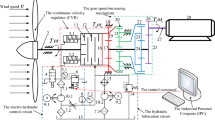Abstract
Aiming at the Megawatt (MW) scale wind turbine, a dynamic analysis and simulation method is presented to research blade loads and dynamic characteristics. To consider blade flexible deformation, the whole blade was divided into a number of units. Each unit was treated as a rigid body, the flexible connection between two adjacent units is considered. A nacelle coordinate system, a rotating shaft coordinate system, and a blade coordinate system were employed to describe the wind turbine blade. In those coordinate systems, blade inertial load calculation model, centrifugal force load calculation model and gravity load calculation model are established. Combining load model with the whole model of wind turbines, the real-time dynamic simulation model of blade loads was established in Simulink circumstance and a numerical simulation was performed. Based on the simulation analysis, some research results were obtained. When the large instantaneous fluctuation of electromagnetic torque of generator happens, rotor speed does not appear to have large fluctuation due to the inertia of the wind rotor, but the blade vibration speed changes obviously. Gravity has a periodic variation in the process of blade rotation and has a large influence on the edgewise moment. The research results provide a helpful reference for the structure design, operation, and control of wind turbines.
Similar content being viewed by others
References
J. C. Dai, Dynamic characteristics analyzed of large scale directly-driven wind turbines under blade fracture accident condition, J. of Mechanical Engineering, 49 (2) (2013) 190–198.
M. Geyler and P. Caselitz, Robust multivariable pitch control design for load reduction on large wind turbines, J. of Solar Energy Engineering, 130 (3) (2008) 031014.
K. Selvam et al., Feedback-feedforward individual pitch control for wind turbine load reduction, International J. of Robust and Nonlinear Control, 19 (1) (2008) 72–91.
J. C. Dai et al., Calculation and characteristics analysis of blade pitch loads for large scale wind turbines, Science China Technological Sciences, 53 (5) (2010) 1356–1363.
J. C. Dai et al., Research on joint power and loads control for large scale directly driven wind turbines, J. of Solar Energy Engineering, 136 (2) (2014) 021015.
D. Lee, D. Hodges and M. Patil, Multi-flexible-body dynamic analysis of horizontal axis wind turbines, Wind Energy, 5 (4) (2002) 281–300.
D. Li, Z. Q. Ye and X. H. Huang, The neumann series solution of rotating blade dynamic equations of horizontal axis wind turbine, Acta Energiae Solaris Sinica, 28 (3) (2007) 280–284.
D. A. Peters, Fast floquet theory and trim for multi-bladed rotorcraft, J. of the American Helicopter Society, 39 (4) (1994) 82–89.
K. Stol, M. Balas and G. Bir, Floquet modal analysis of a teetered-rotor wind turbine, J. of Solar Energy Engineering, 124 (4) (2002) 364.
G. Bir, Multiblade coordinate transformation and its application to wind turbine analysis, 2008 ASME Wind Energy Symposium, Reno, Nevada (2008).
X. Liu et al., Dynamic response analysis of the blade of horizontal axis wind turbines, J. of Mechanical Engineering, 46 (12) (2010) 128–134.
J. C. Dai et al., Aerodynamic loads calculation and analysis for large scale wind turbine based on combining BEM modified theory with dynamic stall model, Renewable Energy, 36 (3) (2011) 1095–1104.
D. A. Griffin, Blade system design studies volume ii: Preliminary blade designs and recommended test matrix, United States. Department of Energy (2004).
R. Lanzafame and M. Messina, Fluid dynamics wind turbine design: Critical analysis, optimization and application of BEM theory, Renewable Energy, 32 (14) (2007) 2291–2305.
JR. M. Buhl, A new empirical relationship between thrust coefficient and induction factor for the turbulent windmill state, NREL/TP-500-36834, National Renewable Energy Laboratory (NREL), Golden, Co. (2005).
J. C. Dai et al., Modelling and analysis of direct-driven permanent magnet synchronous generator wind turbine based on wind-rotor neural network model, Proceedings of the Institution of Mechanical Engineers, Part A: J. of Power and Energy, 226 (1) (2012) 62–72.
E. Bossanyi, Gh bladed theory manual, Garrad Hassan and Partners Ltd. (2007).
Author information
Authors and Affiliations
Corresponding author
Additional information
Recommended by Associate Editor Sungsoo Na
Juchuan Dai received his Ph.D. from Central South University (China) in 2011 and is a Visiting Scholar at Newcastle University (UK) in 2016. He is currently an Associate Professor at Hunan university of Science and Technology in China.
Rights and permissions
About this article
Cite this article
Dai, J., Hu, W. & Shen, X. Load and dynamic characteristic analysis of wind turbine flexible blades. J Mech Sci Technol 31, 1569–1580 (2017). https://doi.org/10.1007/s12206-017-0304-0
Received:
Revised:
Accepted:
Published:
Issue Date:
DOI: https://doi.org/10.1007/s12206-017-0304-0




